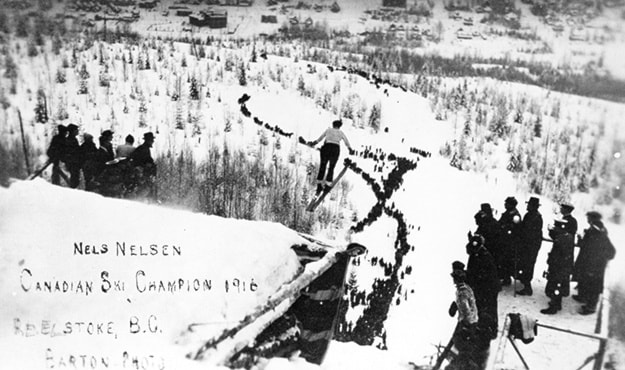100 years ago, Revelstoke played host to the first ski jumping competition in Mount Revelstoke National Park. Suicide Hill, as it was later nicknamed, and local jumper Nels NelseN were the stars of the show.
When tourists flocked to Revelstoke for it's second annual winter carnival on February 8–9, 1916, there was some pressure on the community to live up to its self-proclaimed slogan, Capital of Canada’s Alps. The first carnival was held to much aplomb in 1915, but this year, everything was expected to be bigger and better. Notably, it was the first to make use of the ski jump in Mount Revelstoke National Park, which would later go on to be nicknamed 'Suicide Hill.'
The carnival included a ski jumping competition, and cross-country and snowshoeing races. The ski jump was the most anticipated event, with local hero Nels Nelsen set to compete against visitors from around Canada. Many tourists were expected, and the community was put on notice by the Revelstoke Review.
"It is hoped that everybody, old and young, following the winter sports of skiing, snow-shoeing and tobogganing, will be in line for the torchlight procession on the evening of Tuesday, February 8th," the newspaper wrote. "It is really necessary to turn out for the good name and fame of Revelstoke. There will be numbers of visitors in the city that evening and if we are to live up to our advertising as a winter-sports centre we must impress and please our guests."
Nelsen was the big star. A few weeks earlier, he set a unofficial world record jump of 183 feet on the Big Hill. The Review proclaimed he could top 200 feet.

Skiers and observers attend the 1916 Revelstoke Winter Carnival. ~ Photo contributed by the Revelstoke Museum & Archives
The tournament began with the boys jumping contests and the Nordic ski races (known as ski running at the time) on February 8.
"What a sight it was to see babies even, running down the slopes of Mt. Revelstoke on the winged boards, serene and smiling as friends along the long line of thousands of spectators shouted – ‘well done, kiddie!’” exclaimed the Review in the colourful newspaper language of the time. "And did you see the girls in their trim, neat and athletic costumes, running straight as arrows and swinging along in the ladies' races with very bit as much vim and determination as the boys and young men and even, 'tis true, beating the boys on time for distance."
The main event – the men’s ski jump – was the following day, and the jump was almost as much a star as the skiers.
"As one looked below from the dizzy heights of the judges stand and took in the panoramic background of peaks, rivers and valleys, and dwelt on the noble proportions of the hill itself and its six hundred feet of runaway black with strings of people on foot and in vehicles, and came back to focus on the jump itself with the Union Jack draping its fierce take-off, the scene was altogether worthy of a battle between giants," raved the Revelstoke Herald. The Review proclaimed the hill "has no equal on this continent."
The competition doubled as the BC Championship. The pressure was on Nelsen to take the crown in front of his hometown fans. Unfortunately, the conditions were less than favourable and Nelsen struggled to match his performance of a few weeks prior. His first jump was 136 feet. "It was a magnificent jump, but nothing like what Nelsen can and will do again, under proper conditions," wrote the Herald.
Before his second attempt he complained of a sore foot and was urged not to jump. Still, he went again and soared 152 feet. His hands touched the ground as he stabilized himself on landing. His efforts were good enough to win the gold medal and a case of wine.
"It will be a good, very good man that will take it away from him. It is generally conceded that had Nelsen's foot been right and the weather keen, as it was two weeks ago, twenty more feet would have been added to this jump on a level and (standing) keel," wrote the Review.
That night the town hosted a masquerade ball at the opera house. No doubt the ski jumping was the main topic of conversation. The party was sold out, and then some.

You can get an idea of what it was like to jump off the Big Hill at "Nels Knickers," a new viewing platform and sculpture installed by Parks Canada. ~ Photo by Rob Buchanan, Parks Canada
The Big Hill would become home to three record-setting jumps. The American Henry Hall set a record on it in 1921, only to have Nelsen top him four years later. Another local, Bob Lymburne, set a world record on the jump in 1933 — leaping 287 feet. The jump was named after Nels Nelsen in 1948 and the last ski jumping competition was held there in 1975; it simply became too much effort to maintain because of the huge snowfalls Revelstoke received.
The area is now a historic site in Mount Revelstoke National Park that you can visit to see the old judges tower. In the fall, Parks Canada installed a new sculpture of a jumper so you have your photo taken while you pretend to be Nels Nelsen, soaring through the sky to the town of Revelstoke below. In February, it was given National Historic Designation by the Government of Canada.
